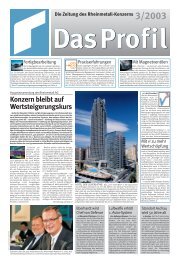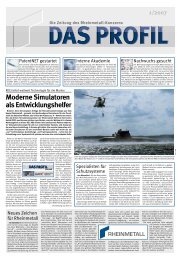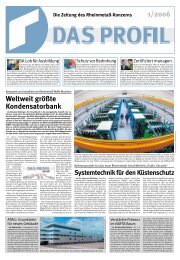PDF [1.6 MB] - Kolbenschmidt Pierburg AG
PDF [1.6 MB] - Kolbenschmidt Pierburg AG
PDF [1.6 MB] - Kolbenschmidt Pierburg AG
Create successful ePaper yourself
Turn your PDF publications into a flip-book with our unique Google optimized e-Paper software.
Neckarsulm. With revenues of € 707 million, KS <strong>Kolbenschmidt</strong><br />
GmbH again raised sales in fiscal 2006, topping its<br />
year-earlier figure by an emphatic 10.8 percent. Annually,<br />
over 6,000 employees at sixteen plants across the world (including<br />
licensees) develop, produce, and market pistons for<br />
passenger and commercial vehicle spark- and compressionignition<br />
engines. The corporate headquarters in Neckarsulm<br />
has been producing pistons now for over 80 years. Founded<br />
in 1910 as Karl Schmidt GmbH by Karl Schmidt (son of Christian<br />
Schmidt, the founder of NSU-Motorenwerke), the company<br />
first started building its aluminum pistons back in<br />
1920. Today, the Neckarsulm facility’s workforce of over<br />
1,250 plus presently 44 apprentices manufacture pistons<br />
Newsline<br />
State-of-the-art steel piston production at KS <strong>Kolbenschmidt</strong> in Necksarsulm<br />
Ultimate performance properties<br />
here are basically two<br />
types of steel pistons: the<br />
articulated-shaft type consisting<br />
of steel plus aluminum<br />
and the all-steel<br />
monobloc piston. Both varieties<br />
are manufactured<br />
by KS <strong>Kolbenschmidt</strong>: the former at the<br />
U.S. plant Karl Schmidt Unisia Inc.,<br />
Marinette, and the latter, the all-steel<br />
variety at Neckarsulm.<br />
Due to their ability to address the<br />
toughest challenges in terms of durability<br />
and robustness, all-steel pistons engineered<br />
for ultimate performance, are<br />
presently gaining ground worldwide. The<br />
design developed<br />
by the Neckarsulm<br />
engineers is based<br />
on a shaft-guided<br />
piston with a long<br />
shaft supported at<br />
the top edge. The<br />
resulting linearity<br />
leads to good<br />
acoustic properties<br />
(cavitation)<br />
while allowing ample<br />
design latitude<br />
in the piston ring<br />
zone which is im-<br />
portant in terms of<br />
Photo: Thomas Klink<br />
oil consumption<br />
and blow-through<br />
volume properties.<br />
Effective temperature control is assured<br />
by a sealed coolant chamber.<br />
Moreover, oil consumption has been<br />
reduced by 55 percent compared with<br />
today’s standard-production articulated-shaft<br />
pistons. The friction-welded<br />
design and the use of quenched and<br />
tempered steel (for high tensile and<br />
endurance strength) allows peak pressures<br />
of up to 250 bar.<br />
It was as early as the start of 2006 that<br />
steel pistons first went into series production<br />
highly successfully following an<br />
extremely brief development phase. In<br />
order to cater for the highly buoyant order<br />
situation as a result of the business<br />
from the chief customer for steel pistons<br />
(DAF Trucks N.V., see also Commercial<br />
Vehicle of 2007 with Pistons from<br />
Neckarsulm), the Neckarsulm location<br />
invested in a new steel-piston production<br />
line.<br />
The manually loaded line used hitherto,<br />
was supplemented by a fully automated<br />
facility for all-steel pistons, subsequently<br />
commissioned in September 2006. “This<br />
ultramodern production line is capable of<br />
turning out annually over 180,000 pistons<br />
for pressures of up to 250 bar,” explains<br />
Michael Janssen, in charge of Project<br />
Management and Process Development<br />
for the Pistons Project.<br />
Before, however, the finished steel pistons<br />
are shipped out to customers a series<br />
of sophisticated machining steps<br />
needs to be carried out. The raw part is<br />
11<br />
from either aluminum or steel. Alongside the production of<br />
aluminum pistons for spark- and compression-ignition passenger<br />
car engines, the Neckarsulm plant since has been<br />
very successfully building steel pistons for commercial vehicle<br />
engines since the start of 2006. The same location<br />
also develops, produces and markets a range of large-bore<br />
pistons that go into a variety of stationary engines, marine<br />
diesels, and locomotives. With the commercial vehicle market<br />
presently flourishing and manufacturers’ order books<br />
brimming, sales by this product group have in the meantime<br />
climbed to 15 percent of total revenues. A further highlight<br />
is the fully automated production line for steel pistons<br />
recently successfully commissioned at the Neckarsulm plant.<br />
Neckarsulm-based <strong>Kolbenschmidt</strong> launched its highly successful steel piston production<br />
for commercial vehicles. Pictured here: Gerhard Luz (l) and Michael Janssen.<br />
supplied by the foundry as a premachined,<br />
heat-treated component. The<br />
pallet-mounted parts then move onto KS<br />
<strong>Kolbenschmidt</strong>’s fully automated conveyor<br />
belt which routes them to the<br />
downstream machining operations.<br />
The pistons are then turned/milled for<br />
fitting-in accompanied by the premachining<br />
of the piston pin hole, and the finishmachining<br />
of the piston crown. Following<br />
the turning of the piston ring groove, the<br />
pin hole is precision bored at the heart of<br />
the production line by a machine specially<br />
developed for this purpose by <strong>Kolbenschmidt</strong>.<br />
The coolant passage is then<br />
sealed by laser welding. Also, the pistons<br />
are given their<br />
final surface profile<br />
and exterior geometry<br />
before, having<br />
been deburred and<br />
cleaned, they undergo<br />
a special surface<br />
finish. Finally, quality<br />
inspection and<br />
identification coding<br />
are carried out. It<br />
is a part of KS strategy<br />
that the all-steel<br />
pistons are readied<br />
for shipment in the<br />
production line.<br />
In order to address<br />
international<br />
markets and the<br />
demands of global customers, a further<br />
automated production line has already<br />
been ordered and will be taken<br />
into operation before year-end 2007.<br />
The uptrend in the steel-piston segment<br />
is reflected, moreover, in several<br />
development projects commissioned<br />
by other commercial vehicle customers.<br />
In all, therefore, KS <strong>Kolbenschmidt</strong> is<br />
facing a bright future in this segment.


![PDF [1.6 MB] - Kolbenschmidt Pierburg AG](https://img.yumpu.com/8657804/11/500x640/pdf-16-mb-kolbenschmidt-pierburg-ag.jpg)
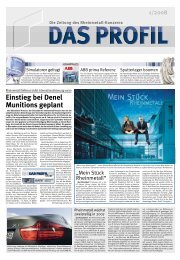



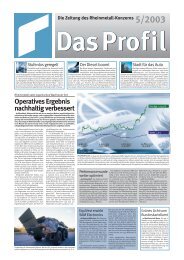
![PDF [2.4 MB] - Kolbenschmidt Pierburg AG](https://img.yumpu.com/8295864/1/184x260/pdf-24-mb-kolbenschmidt-pierburg-ag.jpg?quality=85)
![PDF [2.5 MB] - Kolbenschmidt Pierburg AG](https://img.yumpu.com/8112793/1/184x260/pdf-25-mb-kolbenschmidt-pierburg-ag.jpg?quality=85)




